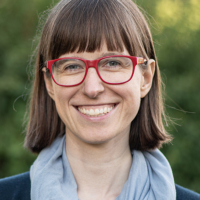This article is brought to you by Datawrapper, a data visualization tool for creating charts, maps, and tables. Learn more.
Conceptually close vs physically close
This week’s Weekly chart is a small one. It’s the calm before the storm – we’re celebrating 52 weeks of Weekly Charts next week. So while everyone talks about the upcoming US election, we will talk about German students and where they live:
If we try, we can see the four big cities in Germany, each one in a different direction: Hamburg in the north, Berlin in the east, Munich in the south and Cologne in the west. These are the only four German cities with more than 1 million inhabitants. And that’s also where most students live, but they don’t make up a big share of the population. The biggest German cities have less than 10% students.
We can also see some dark spots, where more than one in five inhabitants is a student. All of them except Jena are in the former West German states. These are true “student cities”, with a high share of students: Tübingen, Gießen, Marburg, Göttingen, Würzburg, Erlangen.
Chart Choices
To get to the insights I just described, we need to do quite a bit of hovering over the circles. To compare population numbers with each other and to simply name the cities we need to see the content in the tooltips.
Let’s do an experiment. I prepared a scatterplot with the same data. How hard is it to have the same insights as above using this chart type?
Did you find it easier or harder? Personally, I find it easier. Instead of encoding the number and share of students with size and color, we encode it with position – the position on the y & x-axis. This makes it far easier to compare the values with each other. We can see the “big but small share of students”-cities in the bottom right, and the “small but big share of students”-cities in the upper left.
So why did I choose the map as the Weekly Chart and not the scatterplot? Because I can find myself on this map. Almost exactly ten years ago, I started studying in a green circle called Weimar. I can point to this circle and say: “I was there. That’s me.” And then I can point towards other circles and say: “Here were my friends. I visited them. I was there, too”. In a scatterplot, I can only find “my” circle if it has a search function. And even then: The circles around my green circle won’t be named after the cities that were close-by when I studied.
Close-by cities in a scatterplot are conceptually close, not physically close. Close-by cities in a scatterplot will tell me which cities had a similar share of students and number of students similar to Weimar. It will be interesting. But only close-by cities on a map will bring back memories of taking the train to them because Weimar was too small to go shopping properly. It won’t be new information, but it will give me warm feelings.
Both kinds of proximity are important, the conceptual and the physical one. It can be hard to decide between a map and a scatterplot. The great thing is that we can show both! And I’ll see you next week.




Comments